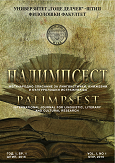THE COGNITIVE APPROACH IN DESCRIBING THE MEANINGS OF PREPOSITIONS
Abstract
This article aims to present the cognitive approach in describing the meanings of the prepositions. The traditional approach completely ignored the question of the link between the different meanings or assumed that the different meanings were interrelated by chance. This approach is applied in the dictionaries, the traditional grammar and in the foreign language textbooks. A new way in describing the meaningful variations of the prepositions has been developed with the cognitive linguistic approach. This approach observes prepositions as multilingual linguistic units where the different meanings are systematically interconnected and form semantic networks. The meaning of the polysemic units such as the prepositions are based on the underlying hypothesis of cognitive linguistics according to which linguistic units do not refer to objects in the external world, but to the concepts in the human mind. This means that semantic structure is identified with the conceptual structure, and therefore the meaning is identified with the concept. The purpose of this article is to explain the basic hypothesis of cognitive linguistics, that the various meanings of the prepositions are interrelated into semantic network formed out of the prototypical meaning.


